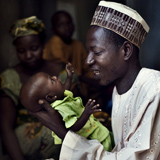
This summary reviews progress with improving early PNC home visits in three States in North Western Nigeria – Kano, Zamfara and Katsina. In these States the ACCESS and MCHIP projects worked in partnership with the Federal and State Ministry of Health. The goal was to reduce maternal and neonatal mortality by delivering a minimum package of maternal and newborn interventions at community and facility levels. In project areas there was a focus on: antenatal care (ANC), comprehensive and basic EmONC, postpartum care, family planning and healthy timing and spacing of pregnancies. The Household-to-Hospital Continuum of Care (HHCC) approach was used. The HHCC addresses all three delays1 associated with maternal and newborn deaths by improving household and care-seeking practices, empowering the community to create and maintain a supportive environment for increased utilization of services, and improving the quality of care provided at health facilities at all levels. ACCESS was operational in Nigeria from January 2006 to December 2009. MCHIP ran the project until December 2011.
The Northwestern States Kano, Zamfara and Katsina have predominantly rural communities and a high burden of maternal and newborn mortality. Coverage with key maternal interventions in the Northwest of the country is generally lower than for the country as a whole. For example, the proportion of pregnant women receiving at least one antenatal care contact from a health professional in the Northwest in 2008 was 31% compared with 58% nationally. Kano State reported 50% ANC coverage while Katsina and Zamfara states reported 14% and 13% respectively. Similarly, the proportion of women delivering with a skilled birth attendant in the Northwest region was 10% compared with the national average of 39%. The rate was 13% in Kano State and 5% and 8% respectively in Katsina and Zamfara States. Contraceptive prevalence shows similar variations, being 10% nationally and 2.5% in the Northwest Region.
Program implementation areas were selected in consultation with local State and Local Government Area (LGA) stakeholders, using a number of criteria including high levels of maternal and neonatal mortality and absence of other donor partners implementing related activities. The program initially targeted two LGAs in each state; by the end of 2011 the project had supported facilities and communities to improve quality of and demand for maternal and newborn care in 29 LGAs. All activities were closely coordinated with MOH staff, and consistent with national policies and strategies outlined in the Integrated Maternal, Newborn and Child Health (IMNCH) strategy.
Please download the full resource.